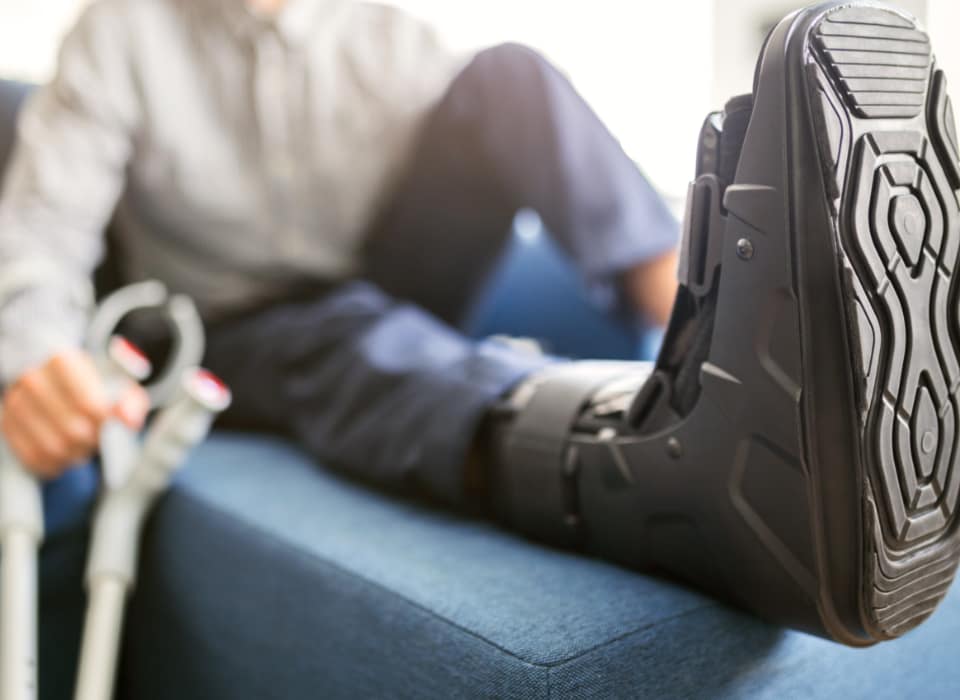Ankle arthritis Perth
What is ankle arthritis?
Your ankles allow you to stand, walk, run and jump. If your ankle hurts, and the pain increases with activity, you may have ankle arthritis or in other words, an inflammation of your ankle joint.
Ankle arthritis happens when cartilage in your ankle joint begins to break down or wear away, causing pain, swelling, and stiffness in the ankle.

Ankle arthritis causes
Cause 1: Osteoarthritis
Osteoarthritis is also known as degenerative or wear-and-tear arthritis. The cartilage in the joint gradually wears away. As the cartilage wears away, the surfaces are roughened and eventually wear down until bone is grinding against bone.
Cause 2: Rheumatoid arthritis
Cause 3: (Posttraumatic) arthritis
Ankle arthritis symptoms
Whether your arthritis is caused by trauma, wear and tear or inflammation, the symptoms of the different types of ankle arthritis are similar:
- Pain
- Stiffness
- Swelling
The two most common forms of arthritis are the first two: osteoarthritis and rheumatoid arthritis. Even though their symptoms may be similar, the treatment will be different.
How is ankle arthritis diagnosed?
If you’re experiencing pain, stiffness, or swelling in your ankle joint, we welcome you to make an appointment at The Foot & Ankle Centre here in Perth.
Before we can diagnose your condition, we may perform a variety of tests.
Clinical examination: We will examine your ankle joint, looking for signs of swelling, tenderness, and stiffness.
Functional assessment: We will also assess your gait; how do you walk? Are there any abnormalities in your posture? How is your pain affecting your daily activities?
Imaging tests: We will look at X-rays to visualise the bones and cartilage in your ankle joint and look for signs of arthritis. Occasionally CT and MRI scans are required
Once a diagnosis of ankle arthritis has been made, your doctor at The Foot & Ankle Centre will work with you and create a personalised treatment plan. This plan may include lifestyle changes, physiotherapy, braces, and medication prescription.

Let’s take a further look at what treatments are available for ankle arthritis.
Ankle arthritis treatment Perth
How is ankle arthritis treated?
The treatment for ankle arthritis depends on how severe your condition is and how it impacts your daily life.
First, we look at non-surgical options to treat ankle arthritis.
Lifestyle changes: Avoiding high-impact exercise, can help to reduce stress on your ankle joint. For example, you might stop running and jogging and replace these activities with cycling and swimming.
Physiotherapy: A physiotherapist can help with range of motion, muscle strengthening and gait improvement.
Assisted devices such as braces: Wearing an ankle brace can help to support your ankle joint, particularly if some instability or deformity is occurring along with the pain. They work by reducing movement and realigning the joint. Special shoes and orthotics also reduce the load on the ankle joint.
Medications: Over-the-counter analgesics may help to relieve pain and reduce inflammation but the regular use of strong painkillers is not advised. Non-steroidal anti-inflammatory medication can help with pain and swelling. These medications have side effects and need to be prescribed and managed by your GP.
Cortisone injections are also used to relieve swelling and pain but are not long-lasting or curative.

Let’s take a look at what types of surgery are available to treat ankle arthritis.
Surgery for ankle arthritis Perth
Ankle arthritis surgery
There are two main types of surgery for ankle arthritis and both are a last resort to control pain and deformity when all other treatments have failed.
Ankle fusion (or arthrodesis) surgically stiffens the joint so it cannot move and thus reduces or abolishes the pain. A sound fusion of the ankle joint vastly improves pain or eradicates it.
Ankle replacement surgery replaces the joint surfaces with an articulating prosthesis that reduces pain and maintains joint movement. Recent technological advances in joint replacements have vastly improved the results of surgery.
A third type of surgery, arthroscopy can be used to remove a painful spur in the early stages of ankle arthritis and can give relief for long periods before the ankle fusion operation is required.
What is right for me? Fusion or replacement?
Who should have a fusion and who should have a replacement is a complex clinical assessment. Younger patients with severe arthritis are more likely prescribed a fusion as they will wear out a replacement prosthesis in a much shorter period of time and therefore require more surgeries. Ankle replacements are contraindicated in some cases where there is bone loss or too much deformity and therefore fusion is better for correction regardless of age.
However, prior to fusion or replacement, less invasive procedures such as arthroscopy (keyhole surgery) can be used in particular with spurs or loose bodies that can form in the ankle. Not everyone benefits from arthroscopy and in a small group of patients arthroscopy can worsen symptoms.
In some patients with deformity, osteotomy (realigning the bones around the ankle) can help to spread the load across the ankle joint and reduce pain.
Recovery after surgery
Ankle fusion recovery
| Big operation: | yes |
| Swelling: | May persist for 6-12 months |
| Supportive boot: | Non-weight bearing is required in a supportive boot for six weeks following surgery. |
| Crutches: | Graduated-weight bearing without crutches is progressed over a further three months. Most patients are independent by six months. |
Ankle replacement recovery
| Big operation: | yes |
| Swelling: | May persist for 6-12 months |
| Supportive boot: | Walking in a supportive boot is usually by six weeks following surgery. |
| Crutches: | Full weight bearing without crutches is achieved by three months from surgery and most patients return to work and activity by six months. |
Self-assessment ankle arthritis
You are not alone
Many people are living with ankle pain and often they don’t know their pain could be caused by arthritis.
We welcome you to make an appointment at The Foot & Ankle Centre. We try to see patients as quickly as possible. Alternatively, The Foot & Ankle Centre has developed a short form that you can use to answer a few questions. You will receive a personal answer from Prof Dr Gerard Hardisty.



